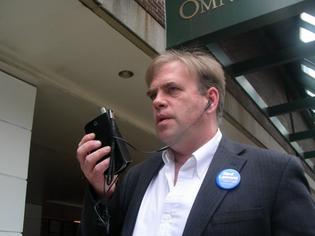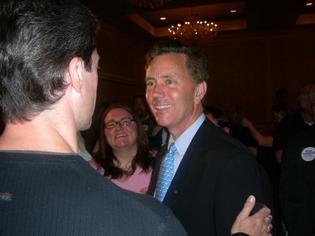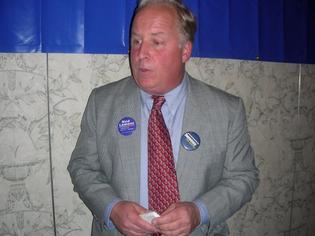 Just like Howard Dean’s 2004 presidential campaign, Ned Lamont’s 2006 Senate quest has attracted an outpouring of idealistic, outsider, Internet-organized donors and volunteers. Many of the same people, in fact. Campaign chief Tom Swan (one of those same people, pictured) vows the Lamont team won’t repeat history and blow all that momentum.
Just like Howard Dean’s 2004 presidential campaign, Ned Lamont’s 2006 Senate quest has attracted an outpouring of idealistic, outsider, Internet-organized donors and volunteers. Many of the same people, in fact. Campaign chief Tom Swan (one of those same people, pictured) vows the Lamont team won’t repeat history and blow all that momentum.
The parallels are unmistakable. A candidate who blasts Geroge Bush, Republican policies and mealy-mouthed centrist Dems excites thousands of liberals disgusted with traditional party organizations. The troops come together via the Internet. They thrill to the populist platform of a trust fund-endowed mad-as-hell candidate. They cheer the candidate’s attacks on establishment D.C. politics, his calls for health care reform, his opposition to tax and social policies that favor the rich, his insistence on redirecting money to domestic needs. They pour in thousands of small donations and promise to round up votes on primary day. They vow to reclaim the Democratic Party from the outside, from the grassroots — and to democratize politics in the process, reclaim elections from high-priced consultants and corporate lobbyists.
That happened with Dean’s Democratic primary campaign for president. Then, when it came time to win primaries, all those troops had little direction or knowledge about how to pull voters. Dean’s campaign crashed.
 Ned Lamont’s campaign to unseat U.S. Sen. Joe Lieberman in an Aug. 8 primary is still in the heady first stage, Big Mo phase. This week the outspent and little-known challenger posted a stunning gain in a Quinnipiac University poll; he suddenly has the support of 40 percent of likely voters. His ads are playing better than Lieberman’s; the powerful three-term incumbent appears on the run. National blogs and adoring national media articles find irresistible the script of underdog Lamont on the way to slaying Goliath. The momentum built to a crescendo Thursday when, hours after the Quinnipiac Poll’s release, hundreds of Internet-organized supporters jammed the New Haven Omni Hotel’s second-floor ballroom for a spirited Lamont rally (pictured).
Ned Lamont’s campaign to unseat U.S. Sen. Joe Lieberman in an Aug. 8 primary is still in the heady first stage, Big Mo phase. This week the outspent and little-known challenger posted a stunning gain in a Quinnipiac University poll; he suddenly has the support of 40 percent of likely voters. His ads are playing better than Lieberman’s; the powerful three-term incumbent appears on the run. National blogs and adoring national media articles find irresistible the script of underdog Lamont on the way to slaying Goliath. The momentum built to a crescendo Thursday when, hours after the Quinnipiac Poll’s release, hundreds of Internet-organized supporters jammed the New Haven Omni Hotel’s second-floor ballroom for a spirited Lamont rally (pictured).
At the rally, Lamont was answering questions like this one from Channel 30: “Why is your message working?”
Now comes the crucial next phase: Transforming the 10,000 volunteers and donors into a force than can pull 70,000 or more votes in the dog days of August.
That job falls to campaign manager Tom Swan — who also happened to serve as Connecticut field director for the 2004 Dean campaign.
“There’s a big difference” between then and now, Swan said. When Dean’s troops swarmed Iowa for a presidential primary — and got whupped — they were in unfamiliar terrain, Swan noted. The Lamont campaign has already accumulated 5,000 volunteers who live here in Connecticut. (Dean had 1,000 volunteers in Connecticut, Swan estimated.)
The Lamont campaign has opened eight offices across the state, and started phone banking in them. Volunteers are organizing house parties for “families, friends and neighbors” — the mantra of Lamont and crew at the Thursday Omni rally. Those supporters are being called on to convince unaffiliated voters to register Democratic in order to vote for Lamont in the primary; to i.d. supporters and compile lists of likely voters; to pump Ned door-to-door.
Another difference in 2000 was that opponents could cut Dean down with attack ads, Swan said. Joe Lieberman has already raised $7 million and started running conventional attack ads against Lamont this year. Besides relying on the $2 million the campaign has raised so far (half from Lamont himself, the rest from primarily small donors across the country), Lamont, a tech-company founder worth between $90 and $300 million, vows to spend what it takes to respond swiftly and tenaciously on the air.
The key battle, though, is on the ground. Wealthy candidates, it turns out, lose as often as they win. They spend too much of their millions on commercials. As Mark Pazniokis pointed out in the Hartford Courant, they win only if they can inspire and organize a sophisticated vote-pulling operation. (Leave aside Michael Bloomberg; that’s a special case.)
 Another parallel between the Dean and Lamont campaigns: the name “Dean.” Howard’s brother Jim (pictured), who lives in Fairfield, heads a group called Democracy for America, a successor to Dean for America. DFA was one of two influential web-organizing groups — the other was three-million-member MoveOn.org — which organized Thursday’s Omni rally and which are raising money for Lamont nationwide.
Another parallel between the Dean and Lamont campaigns: the name “Dean.” Howard’s brother Jim (pictured), who lives in Fairfield, heads a group called Democracy for America, a successor to Dean for America. DFA was one of two influential web-organizing groups — the other was three-million-member MoveOn.org — which organized Thursday’s Omni rally and which are raising money for Lamont nationwide.
Dean (Jim, that is) argued after the rally Thursday that Connecticut’s Deaniacs (as in Howard) are more prepared this year than they were in 2004.
“They’re now in this thing three years,” he said. “They understand phone banking, door knocking, voter contact a lot better. A lot of people in Howard’s campaign hadn’t been involved before. They’re now an experienced force.”
Wishful thinking? Or powerful observation? The next two months will provide the answer, obviously. It will offer an answer to a larger question in the process. Few deny that the dynamics of modern campaigns are changing. But how much? To date, no Daily Kos-infused, Internet-sparked, outsider campaign has actually won. Skeptics call the phenomenon a flash in the pan. Believers call it an unstoppable wave that just may wash ashore first along the Connecticut coast.
The Lamont can take heart in what they hope will be another parallel to 2000. Howard Dean may not have beaten John Kerry in the primaries that year. But he did outlast another primary contender, by the name of Joe Lieberman.